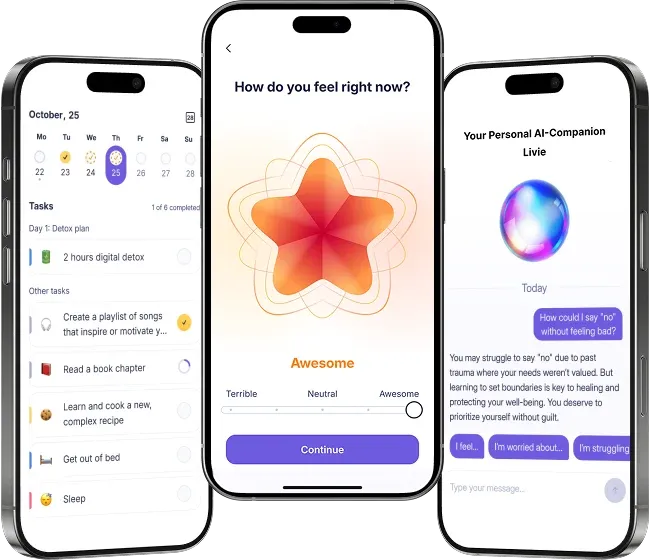What You Need to Know About ADHD in Kids: Signs, Symptoms & Treatment

A child who fidgets endlessly, who buzzes with movement, who tries so hard yet slips off track again and again... Moments like these prompt many parents to pause and wonder whether this is just childhood unfolding or a sign that something more is happening beneath the surface.
Because behind every fidget, pause, or lost pencil is a child doing their best with a brain that works a little differently, and often harder.
Attention deficit hyperactivity disorder (ADHD) is one of the most common neurodevelopmental mental disorders in school-age children, affecting attention, impulse control, and the way a child regulates their energy. Many kids experience distractibility or restlessness at times, but ADHD symptoms are more consistent, more intense, and show up across settings like home, school, and social environments.
And for many parents, naming what’s happening can bring a quiet relief — a sense that the struggle finally has a shape. Below you’ll find a clear, updated, and supportive overview of ADHD in children — including symptoms, diagnosis, treatment options, emotional considerations, and practical steps parents and teachers can take.
Key Learnings
Here’s what we know from current research and clinical guidance:
- Roughly 1 in 9 U.S. children has ever been diagnosed with ADHD; boys are diagnosed more often than girls. Screening and diagnostic rates have been rising. (Source: CDC data)
- Best outcomes are achieved through a combined, individualised approach: behavioural parent training, school adjustments, and stimulants when clinically indicated. Guidelines from major bodies support this. (Source: AAP Clinical Guidelines)
- ADHD can look very different in girls and in inattentive presentations — quieter struggles are easy to miss and link to anxiety and low self-esteem. (Source: NIMH overview)
- Parent and teacher strategies (routines, clear instructions, short tasks, movement breaks) make a measurable difference to daily life. (Source: CDC ADHD overview)
What ADHD Looks Like in Kids
ADHD affects how a child’s nervous system manages focus, self-control, motivation, and transitions. When you understand this, it becomes easier to see your child’s behaviour not as defiance, but as a nervous system trying to keep up.
Children may show:
- Trouble paying attention
- Inattentive symptoms like losing items or making careless mistakes
- Impulsive behaviors (blurting, interrupting, acting without pause)
- Constant motion or difficulty staying seated
- Difficulty starting tasks, organizing materials, or remembering instructions
These challenges do not reflect laziness or poor parenting. ADHD is associated with measurable brain differences in areas that regulate attention, planning, reward sensitivity, and emotional regulation. Many kids with ADHD are working twice as hard as they look, and their effort is often invisible.
Hyperactive symptoms sometimes ease as children grow older, while inattentive ADHD and executive-function challenges can persist into adolescence and adulthood.
Typical Child's Behavior vs. ADHD Symptoms
It’s easy to mistake typical behaviours for ADHD. The distinction is not about what a child can do occasionally, but what they struggle with repeatedly, across settings. Think of it this way: every child loses focus sometimes, but ADHD is when the “sometimes” becomes the rule, not the exception.
| Aspect | Typical behavior | ADHD symptom (persistent, cross-setting) |
| Attention | Shorter spans, but can focus when motivated | Often can’t sustain attention across settings |
| Activity | Energetic but can calm when needed | Constant fidgeting, leaving the seat, and hard to settle |
| Follow-Through | May need reminders, but completes tasks | Frequently leaves tasks unfinished despite prompts |
| Organization | Messy sometimes; can organise with help | Persistent problems planning and organizing |
| Social Interactions | Adjusts to context | Impatient, interrupts, misses social cues |
| Managing Emotions | Occasional outbursts | Frequent intense reactions; trouble self-regulating |
| Accepting Feedback | May get upset, but can take in feedback with reminders | May react strongly to feedback and need more support to self-regulate |
| Learning from mistakes | Adjusts behaviour over time with reminders | May repeat behaviours because working memory and follow-through are harder |
Common Myths and Straight Facts
Myth #1: You can self-diagnose with an online test.
Fact: Online quizzes may highlight concerns, but only a mental health professional or a child’s doctor can diagnose ADHD. They use DSM-5 criteria, detailed developmental history, and validated rating scales (such as Vanderbilt forms). A complete evaluation helps distinguish ADHD from trauma, anxiety, and other learning disorders. If you feel unsure or overwhelmed, you're not alone — most families start this journey with the same questions.
Myth #2: Medication is the only treatment.
Fact: Medication helps many children, but ADHD is most effectively treated with a combination of behavioral therapy, parent education, school support, and behavioral interventions.
Myth #3: ADHD = bad parenting.
Fact: Parenting does not cause ADHD. Genetics, pregnancy factors, brain development, and environmental influences play far bigger roles. Compassionate, consistent parenting can reduce a child’s symptoms, but it cannot create or erase ADHD.
Trauma expert Gabor Maté frames: children’s behaviour is “a communication of their emotional world, not a moral failing.” This perspective alleviates blame and enables families to respond with understanding rather than shame.
Myth # 4: All kids with ADHD are hyperactive.
Fact: Some children have predominantly inattentive ADHD, with fewer outward behaviours and more quiet struggling.
Myth #5: ADHD isn’t genetic.
Fact: ADHD is highly heritable — research estimates a genetic contribution in more than 70% of cases.
Signs and Symptoms (Practical Checklist)
Not all symptoms look loud. Some are whispers — missed details, forgotten instructions, quiet drifting.
Inattention
Children may:
- drift off during conversations
- struggle with multi-step tasks
- lose items frequently
- skip details or make errors
- seem “spacey,” though fully capable
Impulsivity
Impulsive symptoms can include:
- acting before thinking
- interrupting frequently
- rushing through tasks
- difficulty waiting for their turn
Hyperactivity
Hyperactive symptoms can look like:
- pacing or squirming
- talking excessively
- climbing or moving at unexpected moments
- difficulty settling into starting tasks
Younger children tend to show hyperactivity more visibly, while older children, teens, and young adults may feel it more internally as restlessness.
Look for:
- Trouble sustaining focus on schoolwork or play
- Frequent mistakes, difficulty following instructions
- Forgetting routines, losing items
- Fidgeting, running/climbing inappropriately
- Blurting out answers, difficulty waiting for a turn
- Difficulty with organization and time management
If six or more symptoms from either domain are present for at least six months and start before age 12 (and impair daily life), evaluate for ADHD. (DSM-5 criteria applied by clinicians.)
How Symptoms Change with Age
- Preschool (3–5): High activity, self-regulation challenges.
- Elementary (6–12): Inattention and impulsivity often surface in classwork and friendships.
- Teenagers (13–17): Organization, planning, and risk-taking become prominent.
- Young adults (18+): Persistent executive function challenges, time management, relationships, and work impacts.
The intensity of a child’s symptoms often depends on school demands, environment, support systems, and the individual’s coping skills.
ADHD in Girls
ADHD in girls often goes unnoticed. Instead of obvious hyperactivity, many girls show quiet inattention, emotional sensitivity, and a tendency to internalize struggle.
Girls with ADHD face higher risks of low self-esteem, anxiety, depression, eating disorders, and self-harm when their symptoms go unrecognized. Earlier diagnosis protects them from internalizing blame and helps them build healthy coping skills.
Girls may:
- follow instructions yet drift off mentally
- take much longer to finish homework
- hide overwhelm with perfectionism
- mask symptoms socially
- experience shame or anxiety when they can’t keep up
What Causes ADHD?
Understanding causes isn’t about blame; it’s about clarity, compassion, and building the proper support around your child. ADHD isn’t caused by screen time, lack of discipline, or parenting style, though environment can influence a child’s ability to regulate attention and behaviour.
Research points to several risk factors, including:
- genetics
- prenatal exposure to toxins or stress
- prematurity or low birth weight
- disruptions in brain development
- family history of ADHD or substance use disorders
📚 Extra resources on ADHD
➡️ Raising a child with ADHD — parenting skills and strategies
➡️ Signs of childhood trauma in adulthood (why differential diagnosis matters)
How ADHD Is Diagnosed
A good evaluation can feel like someone turning on the lights in a room you’ve been stumbling through for years. A clinician or a child’s doctor will often evaluate a child using:
- DSM-5 criteria (requiring at least six symptoms)
- structured questionnaires (e.g., Vanderbilt) from parents + teachers
- behavioural observations
- developmental and family history
- school reports from the child’s school
This assessment distinguishes ADHD from:
- anxiety
- learning disorders
- trauma-related symptoms
- Oppositional Defiant Disorder
- sensory differences
💡Note: There is no blood test, brain scan, or single psychological test that can diagnose ADHD.
Evidence-Backed Treatments
ADHD is best treated with a personalized treatment plan that may include:
1. Behavioral Therapy + Parent Training
A first-line treatment for younger children. Helps parents:
- strengthen positive behaviors
- reduce conflict
- build predictable routines
- apply consistent consequences
These behavioural interventions improve daily functioning and reduce stress for the whole family.
2. School Supports
Working closely with your child’s school can help tailor:
- seating near the teacher
- visual instructions
- movement breaks
- chunked assignments
- extended time for specific tasks
- a reward system shared with the home
These accommodations often result in fewer ADHD symptoms during the school day.
3. ADHD Medications
For some children, ADHD medications, particularly stimulants, significantly reduce symptoms. They can improve learning, motivation, and emotional regulation. Medication isn’t a magic fix, but for many children, it opens access to social and academic growth.
4. Healthy Lifestyle Factors
A healthy lifestyle supports the nervous system and reduces symptom intensity:
- consistent sleep routines
- morning sunlight
- physical activity
- balanced diet (reducing sugar helps some children)
- limiting screen time before bed
- predictable daily structure
Practical Parenting Tips for Children With ADHD
Remember: it’s the small, repeated moments of connection — not perfection — that reshape a child’s sense of themselves.
- Give one instruction at a time
- Use simple, direct language
- Break tasks into small steps
- Create predictable routines
- Use timers to support time awareness
- Offer movement breaks between tasks
- Focus on effort rather than perfection
- Praise positive behaviours immediately
- Use visual planners or checklists
- Punishment rarely works; positive reinforcement and consistent boundaries do.
Final Thoughts: Why Early Support Matters
When ADHD goes unnoticed or unsupported, kids often end up blaming themselves for challenges that were never about willpower. Over time, that can ripple into low self-esteem, school struggles, sleep issues, emotional ups and downs, and difficulties with peers. Some teens even turn to risky behaviors to cope.
But early diagnosis changes the story. With the right plan, kids learn tools that strengthen their confidence, support emotional balance, and help them build healthy, connected relationships. The sooner we understand their needs, the sooner they can thrive in a life where their strengths take the lead.
References
- Centers for Disease Control and Prevention. (2022). Data and statistics about ADHD. https://www.cdc.gov/nchs/products/databriefs/db478.htm
- Centers for Disease Control and Prevention. (2023). ADHD: Symptoms, diagnosis, and treatment. https://www.cdc.gov/adhd
- Lansbury, J. (2024). Dr. Gabor Maté on why parents matter more than ever [Audio podcast episode]. In Janet Lansbury Unruffled. https://www.janetlansbury.com/2024/04/dr-gabor-mate-on-why-parents-matter-more-than-ever/
- National Institute of Mental Health. (n.d.). Attention-deficit/hyperactivity disorder (ADHD). https://www.nimh.nih.gov/health/topics/attention-deficit-hyperactivity-disorder-adhd
- American Academy of Pediatrics. (2019). Clinical practice guideline for the diagnosis, evaluation, and treatment of attention-deficit/hyperactivity disorder in children and adolescents. Pediatrics, 144(4), e20192528. https://publications.aap.org/pediatrics/article/144/4/e20192528/81590
- Hopestream Community. (2023). Dr. Gabor Maté on "The Myth of Normal": The roots of our kids’ struggles and a path to healing [Podcast]. https://hopestreamcommunity.org/podcast/dr-gabor-mate-on-the-myth-of-normal-the-roots-of-our-kids-struggles-pressure-on-todays-parents-the-need-for-community-and-a-path-to-healing-2/
- Cortese, S., Faraone, S. V., Asherson, P., Banaschewski, T., Brandeis, D., Coghill, D., Daley, D., Dittmann, R. W., Holtmann, M., Santosh, P., & Simonoff, E. (2023). Attention-deficit/hyperactivity disorder: Clinical insights, current research, and future directions. Frontiers in Psychiatry, 14, 1004429. https://pmc.ncbi.nlm.nih.gov/articles/PMC10044299/
FAQ: ADHD in Children
What are the most common ADHD symptoms in children?
How is ADHD diagnosed in kids?
Can younger children be diagnosed with attention deficit disorder?
What is inattentive ADHD?
How is ADHD treated?
Does ADHD mean a child will have problems at school?
Is ADHD caused by bad parenting?
Do kids outgrow ADHD?
Do ADHD medications work for all children?
What lifestyle changes help manage symptoms of ADHD?

